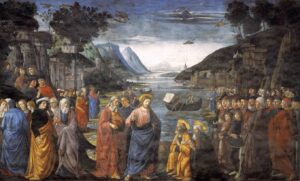We are well enough aware of the way the Transfiguration scene of Jesus alludes to Moses’ change of appearance on the mountain. Less obvious are the allusions to what follows in the Gospel of Mark:
| Commentary | Mark | Exodus – Numbers |
| Moses was also transfigured once and when he descended from the mountain of his transfiguration, the children of Israel were afraid to approach him: just as, according to the original account (Mark 9:15), the people were terrified when they saw Jesus again after his return from the mountain (Luke and Matthew did not understand the meaning of this passage and omitted it).
Note, however, the contrast: while the people feared to approach Moses so that he had to wear a veil over his face, the disciples of Jesus do not fear, though greatly astonished, and run immediately to greet him. |
9:2 . . . And he was transfigured before them, 3 and his clothes became radiantly white, more so than any launderer in the world could bleach them.
9:15 When the whole crowd saw him, they were greatly amazed [=ἐξεθαμβήθησαν] and ran at once and greeted him The same word for the reaction of women seeing the young man clothed in white in the tomb in place of Jesus — 16:5 As they entered the tomb, they saw a young man dressed in a white robe sitting on the right side, and they were alarmed [=ἐξεθαμβήθησαν]. |
Ex 34:29 And when Moses went down from the mountain, . . . . Moses knew not that the appearance of the skin of his face was glorified, when God spoke to him. 30 And Aaron and all the elders of Israel saw Moses, and the appearance of the skin of his face was made glorious, and they feared to approach him. |
| When Moses ascended the mountain on an earlier occasion, he took with him, besides the seventy elders, three of his disciples, so Jesus chose three disciples to witness the miraculous appearance that was to take place on the mountain. | 9:2 Jesus took with him Peter, James, and John and led them alone up a high mountain privately. And he was transfigured before them, | Ex 24:9 Then Moses went up, also Aaron, Nadab, and Abihu, and seventy of the elders of Israel, 10 and they saw the God of Israel. |
| Six days Moses was on the mountain of his transfiguration and on the seventh day the voice from the cloud spoke to him – so Jesus climbs the mountain on the sixth day after Peter’s confession and it was also on the seventh day when the voice from the cloud called out: this is my beloved Son. | 9:2 Six days later Jesus took with him Peter, James, and John and led them alone up a high mountain privately . . .
9:7 Then a cloud overshadowed them, and a voice came from the cloud, “This is my one dear Son. . . .” |
Ex 24:16 and the glory of the Lord settled on Mount Sinai. For six days the cloud covered the mountain, and on the seventh day the Lord called to Moses from within the cloud. |
| Moses had already appointed assistants to judge the people in his name, and he had reserved only the more difficult matters for his decision. When he ascended the mountain of his transfiguration, he left the seventy elders below with Aaron and Hur, so that whoever had a matter might turn to them. So the disciples are also below, while the Lord is on the mountain so that a matter is indeed brought before them, but it is too difficult for them, and after they have tried in vain, it is only settled by the Lord. | 9:16 He asked them, “What are you arguing about with them?” 17 A member of the crowd said to him, “Teacher, I brought you my son, who is possessed by a spirit that makes him mute. 18 Whenever it seizes him, it throws him down, and he foams at the mouth, grinds his teeth, and becomes rigid. I asked your disciples to cast it out, but they were not able to do so.” | Ex 24:14 And [Moses] said to the elders, “Wait here for us until we come back to you. Indeed, Aaron and Hur are with you. If any man has a difficulty, let him go to them.” |
| When Moses came down from the mountain, he heard from afar the shouting and tumult in the camp (Ex 32:17) – so Jesus, on his return from the mountain, finds the disciples surrounded by a great crowd of people and scribes and in a lively quarrel with them. | 9:14 When they came to the disciples, they saw a large crowd around them and experts in the law arguing with them. . . . | Ex 32:15 Moses turned and went down the mountain with the two tablets of the covenant law in his hands. . . . 17 When Joshua heard the noise of the people shouting, he said to Moses, “There is the sound of war in the camp.” |
| The similarity is also evident in the fact that Jesus, just as Moses had reason to complain about what had happened during his absence, also had to complain about the fact that his constant presence was required. | 19 He answered them, “You unbelieving generation! How much longer must I be with you? How much longer must I endure you? | Num 14:26 The Lord spoke to Moses and Aaron: 27 “How long must I bear with this evil congregation” |
Most of the above are from BB





